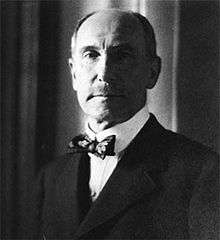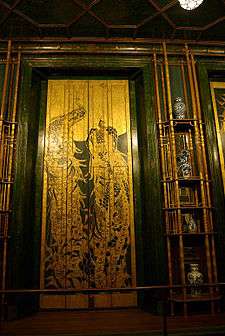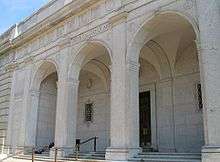Charles Lang Freer
| Charles Lang Freer | |
|---|---|
 1916 photograph portrait by Edward Steichen. | |
| Born |
February 25, 1854 Kingston, New York, United States |
| Died |
October 25, 1919 (aged 65) New York City, New York, United States |
| Resting place |
Wiltwyck Cemetery 41°55′24.4″N 74°00′21.2″W / 41.923444°N 74.005889°W |
| Residence |
Charles Lang Freer House Detroit, Michigan, United States |
| Occupation | Businessman |
| Known for | Collector of Asian and American art. |
Charles Lang Freer (February 2, 1854 – October 25, 1919) was an American industrialist and art collector, best known for his large collection of Asian and American Art which he donated to the Smithsonian Institution in 1906. In addition to this 2,250-object collection, including James McNeill Whistler’s Peacock Room, Freer also founded and funded the construction of the Freer Gallery of Art in Washington, D.C. to house his collection.
Early life
Freer was born in Kingston, New York, in 1854 or 1856.[1] As a teen, rather than finish high school, he went to work as a business clerk for a business. There, he was noticed by Frank J. Hecker, the manager of a local railroad, who hired Freer as a bookkeeper.[1] In the 1870s, a group of investors from Detroit decided to build a rail line in Logansport, Indiana; they hired Hecker to manage the project. Hecker brought the younger Freer along.[1]
Railroads
Although the project was eventually merged out of existence, the investors were happy with Hecker and Freer, and invited the two to Detroit.[1] In 1885, using their own capital and that of investors, Hecker and Freer formed the Peninsular Car Company to build rail cars. The investment made both wealthy, as Peninsular became Detroit's second largest car manufacturer, merging to become the Michigan-Peninsular Car Company in 1892.[1] At the time, Michigan-Peninsular Car was Michigan's largest manufacturer. It merged again into American Car and Foundry in 1899.[2]
Art Collection

In the later part of the 19th century, Freer was diagnosed with neurasthenia, the treatment for which was to concentrate on less stressful activities than business.[1] Freer chose to begin an art collection, and by 1886 began collecting American masters, including a number of impressionist painters.[1]
Early on, Freer met and began collecting the works of James Whistler, eventually becoming perhaps the most important collector of Whistler's work. He collected works by a number of Nineteenth Century American masters, including paintings by Winslow Homer, John Singer Sargent, Augustus Saint-Gaudens, Childe Hassam, and John Twachtman.[3] He began purchasing paintings from Europe, but his artistic advisors (notably Whistler) suggested Freer concentrate on collecting Asian art.[1]
In 1890 Freer contracted with Wilson Eyre to design a home in Detroit. The house (now on the National Register of Historic Places), on Ferry Street next door to Hecker's home, was completed in 1892.[1] Later additions above the stable included space for an art gallery. In 1903, the year of Whistler's death, the Peacock Room was carefully removed from Frederick Leyland's home at 49 Princess Gate, London, and offered for sale at Orbach's gallery in Bond Street. Freer bought the room in 1904 and had Eyre design another room in the carriage house in which to install it.[4]
In 1899, Freer began to disengage from the rail car business, selling his stocks and collecting art over the next 20 years until his death.[1] He traveled to China, Japan, and Sri Lanka. He purchased important Chinese paintings and bronzes from dealers and middle men such as John Calvin Ferguson, an American, and C.T. Loo, a Chinese based in New York, who took advantage of their close ties with prominent Chinese to buy treasures from impoverished families. Freer commissioned photographs of the Buddhist caves and sculptures at the Longmen Grottoes, which were largely looted later in the 20th century. After the death of Ernest Fenollosa in 1908, Freer was considered one of the authorities on Asian art. The historian Warren Cohen concludes that Freer and Ferguson were primarily responsible for the "golden age" of East Asian art collecting. Freer's money and taste and connoisseurship made it possible for the American public to see and for American scholars to study a much wider and more representative body of art, and led directly to a shift in American taste away from decorative and ornate works.[5] Freer amassed what may have been the largest private art collection in the country, including over 30,000 pieces.[1]
In 1906, while on a visit to Egypt, he was offered, and purchased, a number of ancient biblical manuscripts, dating from the third to the sixth centuries, and including the Codex Washingtonianus.[6]
Freer Gallery of Art

Early in the 20th century, Freer decided he should donate his art collection to the public, to be housed in Washington, D.C. Freer was friends with James McMillan, a US Senator and owner of the Michigan Car Company that had merged with Hecker and Freer's Peninsular Car Company.[1] McMillan championed the idea of a beautiful capital city, and Freer approached the Smithsonian Institution to propose building a Washington art gallery for his collection.[1]
The then-director of the Smithsonian, Samuel P. Langley, turned down the idea, perhaps afraid of the cost of upkeep of such a bequest.[1] Freer persevered, contacting President Theodore Roosevelt (and commissioning Gari Melchers to paint a portrait of Roosevelt), and later his wife Edith. Edith prevailed on Roosevelt to back the project, and Roosevelt essentially directed the Smithsonian to accept Freer's gift.[1]
In 1916, construction began on what is now known as the Freer Gallery in Washington. The building cost one million dollars, all of which was paid by Freer.[1] Completion was delayed by World War I and the gallery was not opened until 1923.
Works
Death
Freer died in 1919 while staying at the Gotham Hotel at Fifth Avenue and 55th Street, New York City of what was described as a stroke of apoplexy. He left the bulk of his art collection, more than 5000 objects, to the federal government; it is now housed in the Freer Gallery of Art, Smithsonian Institution. Freer had no wife or children.[7]
Other
Freer is famous not only for having been an industrialist and art collector, but also an avid writer. His personal communications (letters and telegrams) between himself and Whistler have been published and are legendary in the art community. He also shared decades-long communications between himself and other important American art collectors and patrons.
A few of these early patrons went on to establish collections similar in importance (if not necessarily volume) to that of Freer. See: The Phillips Collection, The Vess Collection, The Roosevelt Collection, and others.
The Detroit Century Box, a time capsule, contains a letter written by Freer in 1900.[8]
See also
- Biblical Manuscripts in the Freer Collection
- Charles Lang Freer medal
- Tomlinson, Helen N., Charles Lang Freer, Pioneer Collector of Oriental Art, 1979 Case Western Reserve University
References
- 1 2 3 4 5 6 7 8 9 10 11 12 13 14 15 16 Charles Lang Freer Home from Detroit1701.org
- ↑ Willis F. Dunbar and George S. May, Michigan: A History of the Wolverine State, 3rd Revised Ed. (Grand Rapids: William B. Eerdmans, 1995), 413-4.
- ↑ American Art Gallery Guide from the Freer Gallery
- ↑ Freer House history Archived May 16, 2008, at the Wayback Machine. from the Merrill Palmer Institute.
- ↑ Cohen, Warren I. (1992). East Asian Art and American Culture: A Study in International Relations. New York: Columbia University Press. pp. 71–73. ISBN 0231076444.
- ↑ Collections: Biblical Manuscripts, Smithsonian Institution
- ↑ Obituary (26 September 1919). "Charles L. Freer, Art Collector, Dies". New York Times. Retrieved 29 March 2012.
- ↑ "Letter written by Charles L. Freer". Detroit Historical Society.
Sources
- With kindest regards: the correspondence of Charles Lang Freer and James McNeill Whistler, 1890-1903, Authors Charles Lang Freer, James McNeill Whistler, Editor Linda Merrill, Freer Gallery of Art, Smithsonian Institution Press, 1995
External links
- About Charles Lang Freer and the Smithsonian's Freer Gallery of Art
- Freer and Sackler Galleries, the Smithsonian's national museums of Asian art
- Charles Lang Freer papers from the Smithsonian
- George Bulanda "The Legacy of Charles L. Freer" Check
|url=value (help). Hour Detroit. February 2008.